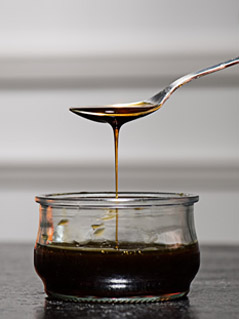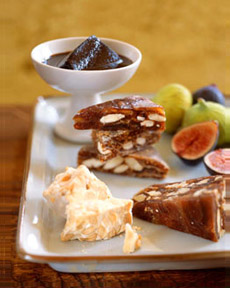TIP OF THE DAY: Try Arrope
 Arrope syrup. There’s also an arrope preserve with pumpkin (see photo below). Photo courtesy Miel de Palma. |
Arrope (ah-ROE-pay), a cooking and condiment syrup, is a product that few of us have in our kitchens. Yet, if you’re a serious cook (or eater), it’s an ingredient you should know about.
If your parents are serious cooks/eaters, it’s an idea for a Mother’s Day or Father’s Day gift—so much tastier than another scarf or tie. And if no one cooks, there’s a delicious arrope pumpkin preserve, a recipe that derives from the ancient use of arrope to preserve or stew fruits. The pumpkin is cooked in the arrope until it is candied. It’s delicious as a sweet-and-earthy bread spread or a condiment with creamy goat’s or sheep’s milk cheeses (see photo below). In fact, when you go to purchase arrope, you need to be specific. Otherwise, you can easily be sold the preserve instead of the syrup, or vice versa. Tip: If the word “pumpkin” appears, it’s the preserve. WHAT IS ARROPE A reduction of grape must, arrope is a condiment that dates to ancient Rome, where it was called defrutum or sapa. It survives as a gourmet Spanish condiment. The name comes from the Arabic word rubb, syrup. |
|
|
Arrope is closely related to saba (also called sapa, mosto d’uva cotto and vin cotto). This group comprises ancient precursors to “modern” balsamic vinegar, which appeared in the 11th century. So if you’re a balsamic vinegar fan, chances are good that you’ll be happy to discover arrope. |
||
|
Like honey* and saba, in the days before sugar was widely available arrope was used to add sweetness. Today it is used in everything from drinks to salad dressings to sauces to desserts (try it with fruit salad or drizzled over ice cream). We use it as a glaze for roast poultry and meats. It easily substitutes in cooking for sweet wines such as sherry and marsala.
As civilization embraced massed-produced foods over artisan products in the latter half of the 20th century, the craft of making arrope—which involves carefully cooking down the must into a syrup over a period of weeks—has almost disappeared. It survives among a handful of artisan producers, carrying on family traditions. (Before modern times, arrope was made by the cook of the family.) In Spain, the few remaining artisans produce arrope syrup (grape must reduction) and preserved pumpkin. While it’s no leap to combine arrope in Spanish recipes, you can port it over to any cuisine—just as with Italy’s saba and France’s verjus. |
 A Spanish cheese plate with typical condiments: fig cake, fresh figs, and in the back, a bowl of arrope preserve with candied pumpkin. |
|
|
*Honey is sweet and syrupy straight from the hive (or straight from the hive and pasteurized). Arrope and saba are cooked to develop sweet-and-sour flavors including notes of cooked caramel. HOW ARROPE IS MADE It starts with a large quantity of grape must, freshly pressed grape juice that still contains all of the skins and seeds and stems. The must is very flavorful with high levels of sugar.
|
||


